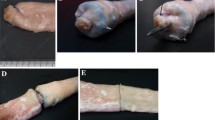Abstract
Background
The single stapling technique (SST) and the double stapling technique (DST) are common anastomoses for rectal cancer. Although many mechanical devices have been developed, the best choice remains unclear. In this study we examined the strength of anastomoses by determining their bursting pressures using an animal model.
Methods
The intestines of pigs were used. In experiment 1, we compared the bursting pressures for Endo GIA™ 60 blue, Endo GIA™ 60 green, and GIA™ 60 blue. In experiment 2, the bursting pressures of a buttressed cutting site and a nonbuttressed cutting site were measured. In experiment 3, the SST, DST, and DST with buttress using PCEEA™ were performed and the bursting pressures and points of these anastomoses were examined.
Results
The bursting pressure of Endo GIA 60 blue (80.3 ± 10.5 mmHg) was significantly higher than that of Endo GIA 60 green (37.3 ± 4.2 mmHg) and GIA 60 blue (31.7 ± 5.8 mmHg) (p < 0.01). When a cut end was buttressed, the bursting pressure (149.6 ± 37.6 mmHg) was significantly higher than that of the nonbuttressed end (75.3 ± 25.1 mmHg) (p < 0.01). The bursting pressure among SST, DST, and DST with buttress was not significantly different. Only one bursting point was the crossing point of the PCEEA and Endo GIA and the bursting pressure of this point was much lower than that of the others.
Conclusion
Endo GIA was most suitable for DST. The SST, DST, and DST with buttress had almost the same strength. The crossing point of PCEEA and Endo GIA may be a dangerous point for DST.


Similar content being viewed by others
References
Alper D, Ram E, Stein GY, Dreznik Z (2005) Resting anal pressure following hemorrhoidectomy and lateral sphincterotomy. Dis Colon Rectum 48: 2080–2084
Arnold W, Shikora SA (2005) A comparison of burst pressure between buttressed versus non-buttressed staple-lines in an animal model. Obes Surg 15: 164–171
Bardini R, Tosato SM, Termini B (2003) Pursestring placement before transsection of the rectum for facilitating the stapled low colorectal anastomosis. Dis Colon Rectum 46: 1712–1714
Bittorf B, Stadelmaier U, Gohl J, Hohenberger W, Matzel KE (2004) Functional outcome after intersphincteric resection of the rectum with coloanal anastomosis in low rectal cancer. Eur J Surg Oncol 30: 260–265
Bluett MK, Healy DA, Kalemeris GC, O’Leary JP (1986) Comparison of automatic staplers in small bowel anastomoses. South Med J 79: 712–716
Chiarugi M, Buccianti P, Sidoti F, Franceschi M, Goletti O, Cavina E (1996) Single and double stapled anastomoses in rectal cancer surgery; a retrospective study on the safety of the technique and its indication. Acta Chir Belg 96: 31–36
Graf W, Glimelius B, Bergstrom R, Pahlman L (1991) Complications after double and single stapling in rectal surgery. Eur J Surg 157: 543–547
Hardacre JM, Mendoza-Sagaon M, Murata K, Talamini MA (2000) Use of a cauterizing laparoscopic linear stapler in intestinal anastomosis. Surg Laparosc Endosc Percutan Tech 10: 128–132; discussion 133–134
Hendriks T, Mastboom WJ (1990) Healing of experimental intestinal anastomoses. Parameters for repair. Dis Colon Rectum 33: 891–901
Knight CD, Griffen FD (1980) An improved technique for low anterior resection of the rectum using the EEA stapler. Surgery 88: 710–714
Luna-Perez P, Rodriguez-Ramirez SE, Gutierrez de la Barrera M, Labastida S (2002) Multivariate analysis of risk factors associated with dehiscence of colorectal anastomosis after anterior or lower anterior resection for sigmoid or rectal cancer. Rev Invest Clin 54: 501–581
Ostericher R, Lally KP, Barrett DM, Ritchey ML (1991) Anastomotic obstruction after stapled enteroanastomosis. Surgery 109: 799–801
Ravitch MM, Steichen FM (1979) A stapling instrument for end-to-end inverting anastomoses in the gastrointestinal tract. Ann Surg 189: 791–797
Roumen RM, Rahusen FT, Wijnen MH, Croiset van Uchelen FA (2000) “Dog ear” formation after double-stapled low anterior resection as a risk factor for anastomotic disruption. Dis Colon Rectum 43: 522–525
Sato H, Maeda K, Hanai T, Matsumoto M, Aoyama H, Matsuoka H (2006) Modified double-stapling technique in low anterior resection for lower rectal carcinoma. Surg Today 36: 30–36
Steichen FM (1968) The use of staplers in anatomical side-to-side and functional end-to-end enteroanastomoses. Surgery 64: 948–953
Vignali A, Fazio VW, Lavery IC, Milsom JW, Church JM, Hull TL, Strong SA, Oakley JR (1997) Factors associated with the occurrence of leaks in stapled rectal anastomoses: a review of 1,014 patients. J Am Coll Surg 185: 105–113
Acknowledgment
The authors thank Tycohealth Care Japan for technical support.
Author information
Authors and Affiliations
Corresponding author
Rights and permissions
About this article
Cite this article
Kawasaki, K., Fujino, Y., Kanemitsu, K. et al. Experimental evaluation of the mechanical strength of stapling techniques. Surg Endosc 21, 1796–1799 (2007). https://doi.org/10.1007/s00464-007-9265-1
Received:
Revised:
Accepted:
Published:
Issue Date:
DOI: https://doi.org/10.1007/s00464-007-9265-1




